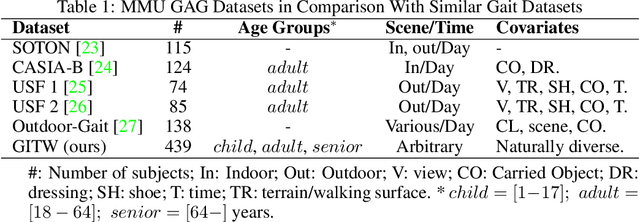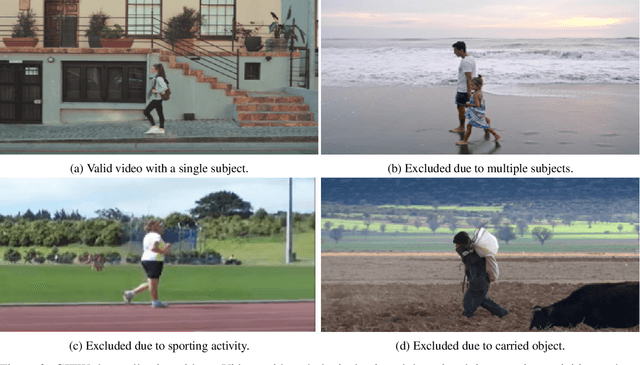Timilehin B. Aderinola
Machine Vision-Enabled Sports Performance Analysis
Dec 18, 2023Abstract:$\textbf{Goal:}$ This study investigates the feasibility of monocular 2D markerless motion capture (MMC) using a single smartphone to measure jump height, velocity, flight time, contact time, and range of motion (ROM) during motor tasks. $\textbf{Methods:}$ Sixteen healthy adults performed three repetitions of selected tests while their body movements were recorded using force plates, optical motion capture (OMC), and a smartphone camera. MMC was then performed on the smartphone videos using OpenPose v1.7.0. $\textbf{Results:}$ MMC demonstrated excellent agreement with ground truth for jump height and velocity measurements. However, MMC's performance varied from poor to moderate for flight time, contact time, ROM, and angular velocity measurements. $\textbf{Conclusions:}$ These findings suggest that monocular 2D MMC may be a viable alternative to OMC or force plates for assessing sports performance during jumps and velocity-based tests. Additionally, MMC could provide valuable visual feedback for flight time, contact time, ROM, and angular velocity measurements.
An Examination of Wearable Sensors and Video Data Capture for Human Exercise Classification
Jul 10, 2023



Abstract:Wearable sensors such as Inertial Measurement Units (IMUs) are often used to assess the performance of human exercise. Common approaches use handcrafted features based on domain expertise or automatically extracted features using time series analysis. Multiple sensors are required to achieve high classification accuracy, which is not very practical. These sensors require calibration and synchronization and may lead to discomfort over longer time periods. Recent work utilizing computer vision techniques has shown similar performance using video, without the need for manual feature engineering, and avoiding some pitfalls such as sensor calibration and placement on the body. In this paper, we compare the performance of IMUs to a video-based approach for human exercise classification on two real-world datasets consisting of Military Press and Rowing exercises. We compare the performance using a single camera that captures video in the frontal view versus using 5 IMUs placed on different parts of the body. We observe that an approach based on a single camera can outperform a single IMU by 10 percentage points on average. Additionally, a minimum of 3 IMUs are required to outperform a single camera. We observe that working with the raw data using multivariate time series classifiers outperforms traditional approaches based on handcrafted or automatically extracted features. Finally, we show that an ensemble model combining the data from a single camera with a single IMU outperforms either data modality. Our work opens up new and more realistic avenues for this application, where a video captured using a readily available smartphone camera, combined with a single sensor, can be used for effective human exercise classification.
Quantifying Jump Height Using Markerless Motion Capture with a Single Smartphone
Feb 21, 2023



Abstract:Goal: The countermovement jump (CMJ) is commonly used to measure the explosive power of the lower body. This study evaluates how accurately markerless motion capture (MMC) with a single smartphone can measure bilateral and unilateral CMJ jump height. Methods: First, three repetitions each of bilateral and unilateral CMJ were performed by sixteen healthy adults (mean age: 30.87 $\pm$ 7.24 years; mean BMI: 23.14 $\pm$ 2.55 $kg/m^2$) on force plates and simultaneously captured using optical motion capture (OMC) and one smartphone camera. Next, MMC was performed on the smartphone videos using OpenPose. Then, we evaluated MMC in quantifying jump height using the force plate and OMC as ground truths. Results: MMC quantifies jump heights with MAE between 1.47 and 2.82 cm, and ICC between 0.84 and 0.99 without manual segmentation and camera calibration. Conclusions: Our results suggest that using a single smartphone for markerless motion capture is feasible. Index Terms - Countermovement jump, Markerless motion capture, Optical motion capture, Jump height. Impact Statement - Countermovement jump height can be accurately quantified using markerless motion capture with a single smartphone, with a simple setup that requires neither camera calibration nor manual segmentation.
Gait-based Age Group Classification with Adaptive Graph Neural Network
Oct 01, 2022



Abstract:Deep learning techniques have recently been utilized for model-free age-associated gait feature extraction. However, acquiring model-free gait demands accurate pre-processing such as background subtraction, which is non-trivial in unconstrained environments. On the other hand, model-based gait can be obtained without background subtraction and is less affected by covariates. For model-based gait-based age group classification problems, present works rely solely on handcrafted features, where feature extraction is tedious and requires domain expertise. This paper proposes a deep learning approach to extract age-associated features from model-based gait for age group classification. Specifically, we first develop an unconstrained gait dataset called Multimedia University Gait Age and Gender dataset (MMU GAG). Next, the body joint coordinates are determined via pose estimation algorithms and represented as compact gait graphs via a novel part aggregation scheme. Then, a Part-AdaptIve Residual Graph Convolutional Neural Network (PairGCN) is designed for age-associated feature learning. Experiments suggest that PairGCN features are far more informative than handcrafted features, yielding up to 99% accuracy for classifying subjects as a child, adult, or senior in the MMU GAG dataset.
 Add to Chrome
Add to Chrome Add to Firefox
Add to Firefox Add to Edge
Add to Edge